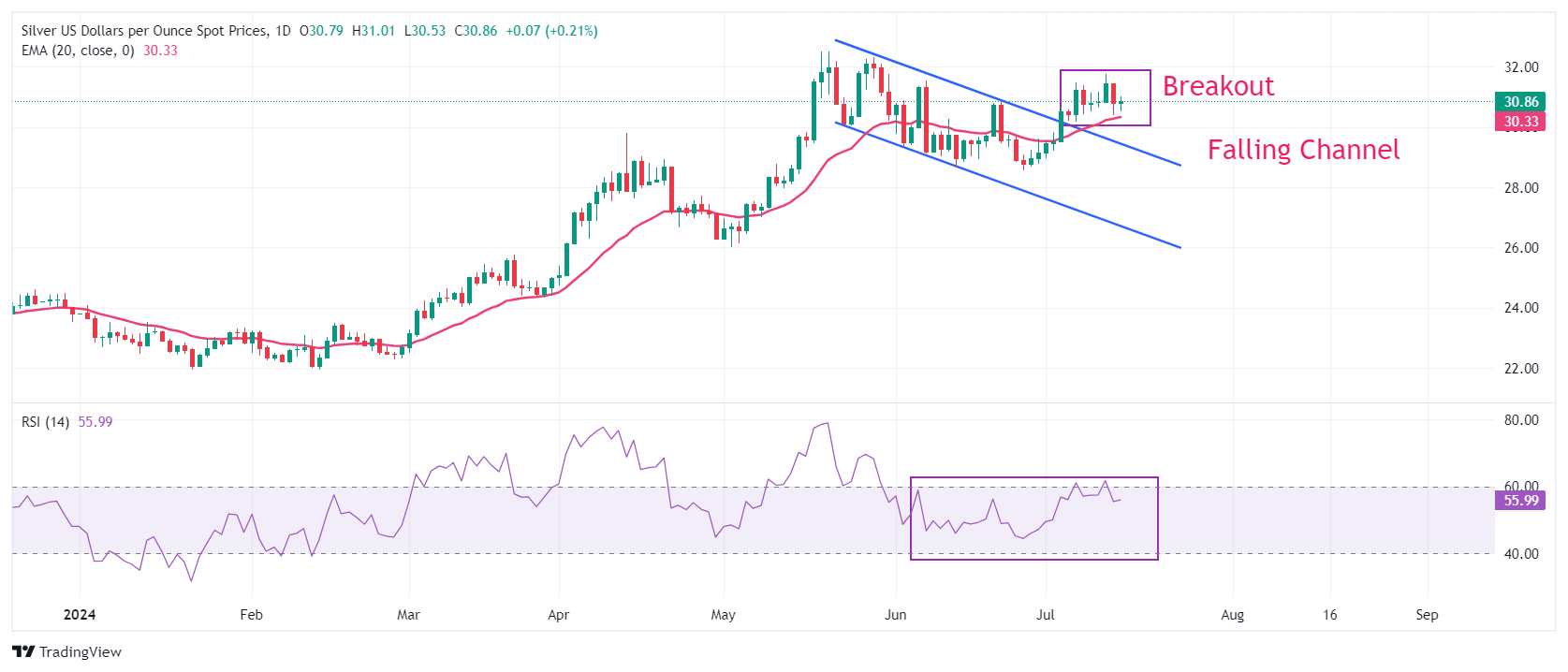Silver Price Forecast: XAG/USD hovers around $31 ahead of Fed Powell’s speech

- Silver price trades in a tight range near $31 amid uncertainty over China’s third plenum outcome.
- Firm Fed rate-cut hopes keep the near-term outlook of the Silver price as bullish.
- Investors await Fed Powell’s speech for fresh guidance on interest rates.
Silver price (XAG/USD) consolidates in a tight range near $31.00 in Monday’s North American session. The white metal struggles for direction as investors await Federal Reserve (Fed) Chair Jerome Powell’s speech at the Economic Club of Washington scheduled at 16:30 GMT.
The commentary from Fed Powell will indicate about when the central bank will start reducing interest rates. Currently, financial markets are confident that the Fed will pivot to policy-normalization from September. Strong speculation for Fed rate cuts in September have weighed heavily on the US Dollar (USD) and bond yields.
The US Dollar Index (DXY), which tracks the Greenback’s value against six major currencies, sees more downside below the immediate support of 104.00. 10-year US Treasury yields rose to 4.22% but are close to near four-month low. Low interest rate environment is unfavorable for the US Dollar and bond yields.
Despite firm Fed rate cut prospects, the near-term outlook of the Silver price is uncertain due to the ongoing four-day China’s third plenum meeting, which is scheduled for next week. China’ Communist Party is expected to take measures to boost real estate and manufacturing sector.
Meanwhile, China’s weaker-than-expected Q2 Gross Domestic Product (GDP) growth has deepened uncertainty over Silver’s demand as a metal used in industry in manufacturing and automobile sectors.
Silver technical analysis
Silver price holds the breakout of the Falling Channel chart formation on a daily timeframe. Advancing 20-period Exponential Moving Average (EMA) near $30.30 continues to provide support to the Silver price bulls.
The 14-period Relative Strength Index (RSI) struggles to break above 60.00. A decisive break above the same would push the momentum toward the upside.
Silver four-hour chart
Silver FAQs
Silver is a precious metal highly traded among investors. It has been historically used as a store of value and a medium of exchange. Although less popular than Gold, traders may turn to Silver to diversify their investment portfolio, for its intrinsic value or as a potential hedge during high-inflation periods. Investors can buy physical Silver, in coins or in bars, or trade it through vehicles such as Exchange Traded Funds, which track its price on international markets.
Silver prices can move due to a wide range of factors. Geopolitical instability or fears of a deep recession can make Silver price escalate due to its safe-haven status, although to a lesser extent than Gold’s. As a yieldless asset, Silver tends to rise with lower interest rates. Its moves also depend on how the US Dollar (USD) behaves as the asset is priced in dollars (XAG/USD). A strong Dollar tends to keep the price of Silver at bay, whereas a weaker Dollar is likely to propel prices up. Other factors such as investment demand, mining supply – Silver is much more abundant than Gold – and recycling rates can also affect prices.
Silver is widely used in industry, particularly in sectors such as electronics or solar energy, as it has one of the highest electric conductivity of all metals – more than Copper and Gold. A surge in demand can increase prices, while a decline tends to lower them. Dynamics in the US, Chinese and Indian economies can also contribute to price swings: for the US and particularly China, their big industrial sectors use Silver in various processes; in India, consumers’ demand for the precious metal for jewellery also plays a key role in setting prices.
Silver prices tend to follow Gold’s moves. When Gold prices rise, Silver typically follows suit, as their status as safe-haven assets is similar. The Gold/Silver ratio, which shows the number of ounces of Silver needed to equal the value of one ounce of Gold, may help to determine the relative valuation between both metals. Some investors may consider a high ratio as an indicator that Silver is undervalued, or Gold is overvalued. On the contrary, a low ratio might suggest that Gold is undervalued relative to Silver.
